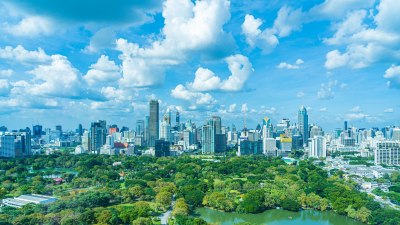Watching the Sea Climb the Steps in Jakarta
Explore the mesmerizing phenomenon of rising sea levels in Jakarta and its impact on the city.

Image by lifeforstock on Freepik
In the bustling metropolis of Jakarta, the vivid interaction between land and sea creates a unique phenomenon that captivates observers: the sea climbing the steps. This awe-inspiring display occurs as rising sea levels, driven by climate change, tidal changes, and urban development, are increasingly evident along the waterfront areas. The beauty of this spectacle comes with a reminder of the challenges residents face in a city that sits just above sea level.
The Geography of Jakarta
Jakarta, the capital of Indonesia, is nestled on the northwest coast of the island of Java. It boasts a long coastline that stretches for about 30 kilometers along the Java Sea. The city’s geographical position inherently makes it vulnerable to the whims of nature. As a low-lying coastal city, Jakarta's landscape consists of a mix of rivers, swamps, and urban development, which creates an intricate relationship between water and land.
Climate Change and Rising Sea Levels
The phenomenon of the sea climbing the steps in Jakarta is intricately linked to the global issue of climate change. As the Earth's temperature continues to rise, glaciers and polar ice caps melt, contributing to the rise in sea levels worldwide. Jakarta experiences this impact directly; it is estimated that the city is sinking at an alarming rate of around 25 centimeters per year in some locations due to groundwater extraction and other human activities. Consequently, even minor increases in sea level can lead to significant flooding, especially during the rainy season.
Historical Perspectives
Historically, Jakarta's development has been significantly influenced by its coastal geography. The city's original settlements were established near rivers and the coast for trade and fishing. However, rapid urbanization and economic development have altered this natural relationship over the years. As buildings and infrastructure have expanded closer to the water, residents have increasingly witnessed the sea's encroachment on urban spaces. The city has made numerous attempts to manage and adapt to these challenges. Yet, as sea levels rise, these efforts face constant scrutiny and require urgent innovation.
Impact on Local Communities
For local communities, the rising sea levels in Jakarta present multiple challenges. Areas that were once frequented by families and tourists are now submerged, impacting livelihoods and daily life. Fishermen struggle with changing tides, while coastal vendors face the prospect of having their stalls inundated by saltwater. Additionally, the psychological impact of watching the sea inch closer to their homes can be daunting for many residents, creating a sense of uncertainty regarding the future.
Environmental Consequences
The environmental ramifications of the sea climbing the steps are profound. With increasing salinity in soil and freshwater supplies, agriculture suffers, affecting local food production. Additionally, ecosystems along the coast, including mangroves and coral reefs, are threatened by rising waters and pollution. This, in turn, disrupts the habitats of various marine species, leading to a decline in biodiversity. These changes not only affect the environment but when considering the interplay with human lives, they raise significant socio-economic issues as well.
Urban Planning and Mitigation Efforts
Jakarta's government has recognized the urgent need for robust urban planning and mitigation strategies to combat rising sea levels. Various projects have been proposed to build sea walls, restore mangrove forests, and improve drainage systems. The government has also initiated a multibillion-dollar plan for the revitalization of the waterfront areas, aiming to create new spaces for recreation while addressing the pressing issue of flooding.
Innovative Solutions
Innovative solutions are crucial in addressing the challenges posed by the sea climbing the steps. For instance, the use of technology in monitoring sea levels and predicting flooding has become paramount. The city has begun to implement early warning systems and adaptive designs in buildings and infrastructure to minimize the risks associated with flooding. Furthermore, investment in sustainable practices, such as rainwater harvesting and waste management, play pivotal roles in reducing the environmental impact of urbanization.
Lessons from Other Coastal Cities
Jakarta is not alone in grappling with the challenges of rising sea levels; many coastal cities worldwide face similar threats. Cities like Amsterdam and Venice have adopted various strategies to adapt and mitigate the impact of water encroachment on urban areas. Lessons learned from these cities can help Jakarta develop tailored solutions that reflect the unique cultural and geographical facets of the region. Through collaborative efforts, knowledge sharing, and community engagement, Jakarta can find inspirations and innovations suitable for its circumstances.
The Role of Community Engagement
Engaging local communities in the conversation around rising sea levels and urban planning is crucial. Residents often hold valuable insights into their environments, making them essential partners in the development of effective strategies. Community-based initiatives focused on awareness raising and education can foster active participation in resilience-building efforts. When communities unite to confront the challenges posed by the sea climbing the steps, they become empowered advocates for their futures.
Future Outlook
The future of Jakarta in the face of rising sea levels remains uncertain. However, by actively pursuing sustainable urban planning, investing in innovative solutions, and fostering community involvement, the city can enhance its resilience against climate change. While watching the sea climb the steps may evoke feelings of fear and uncertainty, it can also inspire collective action towards a more sustainable and secure future. Ensuring that future generations can experience the beauty of Jakarta's waterfront without the encroachment of the sea is achievable, but it requires immediate concerted efforts from all stakeholders involved.
In conclusion, the breathtaking occurrence of the sea climbing the steps in Jakarta serves both as a picturesque wonder and a stark reminder of the city's vulnerabilities. The intertwining of climate change, urban development, and local community dynamics shapes a complex narrative for Jakarta's relationship with its coastal environment. As the city continues to evolve, it must embrace adaptive strategies, foster community engagement, and learn from other experiences worldwide. Only through collective action and innovative solutions can Jakarta hope to navigate the challenges posed by rising sea levels and safeguard its future for generations to come.











